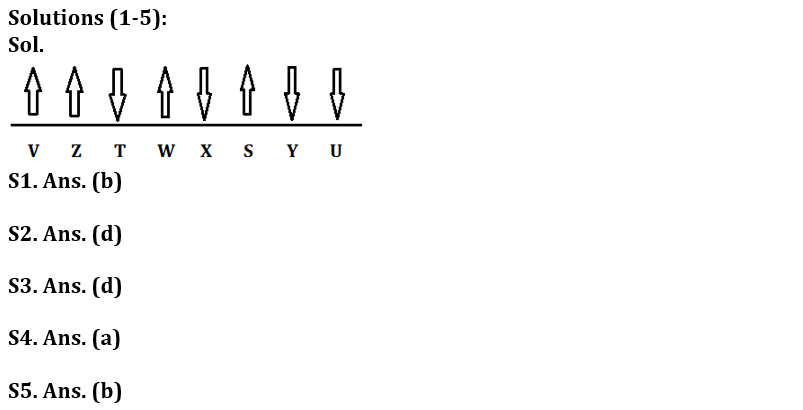Directions (1 – 5): Study the lowing information to answer the given questions.
S, T, U, V, W, X, Y and Z are sit¬ting in a straight line equidistant from each other (but not necessarily in the same order). Some of them are facing south while some are facing north.
Three persons sit between W and U who sits at an extreme end. Y sits third to the right of W. Both the immediate neighbor of W faces opposite direction of W. T sits 2nd to the right of X and both faces south direction. Z and T sits immediate right to each other and none of them sits at any extreme end. S faces north. V doesn’t sit adjacent to U and Y. Y and U faces same direction as T but opposite to V.
Q1. How many persons in the given arrangement are facing north?
(a) More than four
(b) Four
(c) One
(d) Three
(e) Two
Q2. Four of the following five are alike in a certain way, and so form a group. Which of the following does not belong to the group?
(a) W, X
(b) Z, Y
(c) T, S
(d) T, Y
(e) V, U
Q3. What is the position of S with respect to Z?
(a) Second to the left
(b) Third to the right
(c) Third to the left
(d) Fourth to the right
(e) Second to the right
Q4. Who amongst the following sits exactly between Z and W?
(a) T
(b) Y
(c) X
(d) W
(e) U
Q5. Who is sitting 2nd to the right of T?
(a) Z
(b) V
(c) X
(d) W
(e) None of these
Directions: (6-10): In these questions, relationship between different elements is shown in the statements. These statements are followed by three/four conclusions. Read the statements and then decide which of the following conclusions follow from the given statements.
Q6. Statements: D≤M>O, K≥T, D>T
Conclusions: I. T<M II. K=D III. O<K
(a) Only I follows
(b) Only II follows
(c) Only III follows
(d) Only I and II follow
(e) None of these
Q7. Statements: S<T≤U, T>P, I=T≤D
Conclusions: I. I>P II. U≥D III. S≤D
(a) Only III follows
(b) Only I and II follows
(c) Only I follows
(d) Only II and III follow
(e) None of these
Q8. Statements: F<I≤R, P≥L=I>C=E
Conclusions: I. R>E II. P>F III. P≥C
(a) Only I and II follow
(b) Only II and III follow
(c) Only I and III follow
(d) All follow
(e) None of these
Q9. Statements: S≥T, D>E, N≥T, U>E≥N
Conclusions: I. N≤U II. S>E III. T≤D
(a) Only I and II follow
(b) Only II and III follow
(c) Only I follows
(d) Only III follows
(e) None of these
Q10. Statements: K=A<T, P<U, U≥G≥T
Conclusions: I. A>P II. G≥K III. U≥T
(a) Only I and II follows
(b) Only II and III follows
(c) Only I follows
(d) Only III follows
(e) All follow
Directions (11-15): In these questions, relationship between different elements is shown in the statements. The statements are followed by conclusions. Study the conclusions based on the given statements and select the appropriate answer:
Q11. Statements: G>H≤A=W≥U>O>D>C
Conclusion I: H<W II: A>D
(a) If only conclusion I follows.
(b) If only conclusion II follows.
(c) If either conclusion I or II follows
(d) If neither conclusion I nor II follows.
(e) If both conclusions I and II follow.
Q12. Statements: J>W=X>I<P=D>L<F≤R
Conclusion I: X=L II: F>P
(a) If only conclusion I follows.
(b) If only conclusion II follows.
(c) If either conclusion I or II follows
(d) If neither conclusion I nor II follows.
(e) If both conclusions I and II follow.
Q13. Statements: W≤E≤U>C<J≤D<L=S≤I
Conclusion I: C<S II: U<D
(a) If only conclusion I follows.
(b) If only conclusion II follows.
(c) If either conclusion I or II follows
(d) If neither conclusion I nor II follows.
(e) If both conclusions I and II follow.
Q14. Statements: X≤W=S>D=M>K>O≤P≤L
Conclusion I: S≤O II: S>O
(a) If only conclusion I follows.
(b) If only conclusion II follows.
(c) If either conclusion I or II follows
(d) If neither conclusion I nor II follows.
(e) If both conclusions I and II follow.
Q15. Statements: Q≤H=X>M≤O<P<L=D>H
Conclusion I: D>M II: X>L
(a) If only conclusion I follows.
(b) If only conclusion II follows.
(c) If either conclusion I or II follows
(d) If neither conclusion I nor II follows.
(e) If both conclusions I and II follow.
Solutions

S6. Ans. (a)
S7. Ans. (c)
S8. Ans. (a)
S9. Ans. (e)
S10. Ans. (d)
S11. Ans. (b)
Sol. I: H<W (false) II: A>D(True)
S12. Ans. (d)
Sol. I: X=L (False) II: F>P(False)
S13. Ans. (a)
Sol. I: C<S(True) II: U<D(False)
S14. Ans. (b)
Sol. I: S≤O (False) II: S>O(True)
S15. Ans. (a)
Sol. I: D>M(True) II: X>L (False)





 GA Capsule for SBI Clerk Mains 2025, Dow...
GA Capsule for SBI Clerk Mains 2025, Dow...
 The Hindu Review October 2022: Download ...
The Hindu Review October 2022: Download ...
 Hindu Review March 2025, Download Monthl...
Hindu Review March 2025, Download Monthl...





